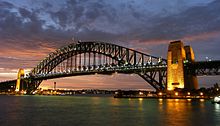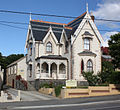Architecture of Australia
| This article is part of a series on the |
| Culture of Australia |
|---|
 |
| Society |
| Arts and literature |
| Other |
| Symbols |
|
Australia portal |
Architecture of Australia has generally been consistent with architectural trends in the wider
Iconic Australian designs include the UNESCO listed Sydney Opera House, Melbourne Royal Exhibition Building, Brisbane City Hall and the 11 remnant penal colony sites selected for World Heritage protection in 2010.
Towards the Federation of Australia there was a concerted movements to create a distinctively Australian styles along with the Australian nationalism movement, some of which incorporated decorative Australiana. While these attempts were largely unsuccessful due in part to cultural cringe, distinctively Australian styles of architecture had already evolved organically. Notable Australian architectural adaptations include the Queenslander and Federation styles of residential architecture.
History

In the period before
Georgian architecture is seen in early government buildings and the homes of the wealthy. The architect Francis Greenway, who appears on the Australian ten-dollar note designed early buildings in the Georgian style. Examples include the Hyde Park Barracks, St James' Church and St Matthews Church at Windsor.[2]
Another European style to gain favour in 19th century Australia, particularly in churches, was Gothic Revival architecture. Pointed arches, turrets, battlements and gothic ornaments could also be found on bank, insurance offices, university buildings and homes.[2] One of the best examples of this style can be seen at the lower end of Collins Street in Melbourne.
With the
One of the most significant architectural movements in Australian architecture was the Federation architecture style of the turn of the 20th century, where Australia began to play with the idea of a "style of our own", and the modern styles of the late 20th century which sought to reject historicism.
One of the most important local introduction to Australian architecture was the
Like elsewhere in the world, socio-political factors have played their roles in shaping Australian architecture. During the early 20th century, cities across Australia had placed building height limits, typically 150 feet (45 m), thus hampering the development of American-style skyscrapers until the limits were lifted in the late 1950s. Likewise the popular notion of the "Australian Dream", in which families seek to own their free-standing houses with backyards, meant that high-density housings were rare in Australia until the end of the 20th century. The design of housing in Australia after World War II, which was mostly undertaken by builders, has been described as poor aesthetically and environmentally.[4]
Significant concern was raised during the 1960s, with
In the 21st century, many Australian architects have taken a more
Australian architectural styles

Architectural styles have been basically exotic and derivative. Only recently have climate and environment played a major role.
During the 19th century, Australian architects were inspired by developments in England. From the 1930s on, North American and International influences started to appear.
Buildings were often heavily influenced by the origins of their patrons, hence while the
Gallery
Victorian
-
Sydney General Post Office, with an ornate mansard roof and clock tower (1891)
-
The Queen Victoria Building (1898), Sydney
-
The Sydney Town Hall (1886)
-
A mix of various Victorian styles along Sydney's York Street
-
Victorian architecture featuring ornate heritage lamp posts and bluestone alleys in Bank Place, Melbourne.
-
The Royal Exhibition Building in Melbourne, built for the 1880s World's Fair is on the World Heritage Register
-
Collins Street, Melbourne 19th-century "boom style" buildings contrast with 20th-century corporate skyscrapers in urban Australia
-
South Melbourne Town Hall (1879)
Post-modernism
-
Parliament House, Canberra: The main entrance and the flag
-
Australian architecture is characterised largely by an international style with moderate alterations, such as the colonial style R.G. Menzies House in Canberra. This is a modern recreation of early American Colonial.
-
Australia Square in Sydney, emblematic of 1960s modernism, was designed by Harry Seidler.
-
Melbourne is home to 71 skyscrapers, the two tallest being Australia 108 (left), the Southern Hemisphere's only 100-plus-storey building, and Eureka Tower (right).
Residential
-
A typical Queenslander house in Ascot, Queensland; a unique regional style influenced by location and climate
-
TheGothic Revival "Garthowen" in Launceston, Tasmania
-
Italianate terrace houses inErskineville, New South Wales
-
19th-century three-storey Victorian terrace houses inEast Melbourne.
-
Tudor house in Mosman, New South Wales
-
Arts and Crafts shingle and bungalow-inspired style home in theUpper North Shore
-
Modern townhouses in Boronia, Victoria on a subdivided plot of land.
Australian architects

Significant architects include:
- Robin Boyd
- John James Clark
- Francis Greenway
- Roy Grounds
- Neville Gruzman
- Harry Howard
- Bryce Mortlock
- Glenn Murcutt
- John Horbury Hunt
- Nonda Katsalidis
- Joseph Reed
- Harry Seidler
- Walter Liberty Vernon
- Mortimer Lewis
- George McRae
- Howard Joseland
- James Barnet
- Lily Isabel Maude Addison
- Edmund Blacket
- Beverley Ussher
- Muir and Shepherd
- Ruth Alsop
- Brit Andresen
- Beverley Bolin
- Eva Buhrich
- Stroma Buttrose
- Kerry and Lindsay Clare
- Louise Cox
- Eleanor Cullis-Hill
- Suzanne Dance
- Maggie Edmond
- Rosina Edmunds
- Zahava Elenberg
- Cassandra Fahey
- Margaret Feilman
- Margaret Findlay
- Abbie Galvin
- Jill Garner
- Eli Giannini
- Eileen Good
- Kristin Green
- Marion Mahony Griffin
- Winsome Hall Andrew
- Laura Harding
- Ellison Harvie
- Beatrice Hutton
- Louise St John Kennedy
- Helen Lochhead
- Bill and Ruth Lucas
- Kirsteen Mackay
- Nellie McCredie
- Margaret Pitt Morison
- Elina Mottram
- Phyllis Murphy
- Andrea Nield
- Ellice Nosworthy
- Alexis Ord
- Shelley Penn
- Christine Phillips
- Susan Phillips
- Caroline Pidcock
- Dimity Reed
- Penelope Seidler
- Mary Turner Shaw
- Muriel Stott
- Florence Mary Taylor
- Jennifer Taylor
- Cynthia Teague
- Kerstin Thompson (
- Yvonne von Hartel
- Emma Young
Significant firms include:
- Ashton Raggatt McDougall
- Bates Smart
- Lyons (architecture firm)
- Searle x Waldron
- Kennedy Nolan
Notable structures

There are many notable structures, of particular importance are:
- the Sydney Opera House, original design being by Jørn Utzon (UNESCO World Heritage)
- the Brisbane City Hall
- the Royal Exhibition Building in Melbourne (UNESCO World Heritage)
- Federation Square, Melbourne
- Parliament House, Canberra
- Sydney Harbour Bridge
See also
References
- ^ )
- ^ ISBN 0-9599271-0-7.
- ^ "Australian Property Investment Co. Building". National Trust Database. Retrieved 10 December 2017.
- ^ ISBN 3-930698-90-0. Retrieved 12 September 2012.
- OCLC 70257350.
External links
- Australian Institute of Architects (AIA)
- Australian Architects under World Architects www.world-architects.com
- ArchitectureAU - online repository of Architecture Australia, the magazine of the Australian Institute of Architects
- Australian Design Review
- Gallery of Australian Architecture
- Gallery of Federation Architecture
- Gallery of Sydney Architecture
- Australian Architects
- Frank and Eunice Corley House Photographs ca. 1970, State Library of Queensland. Large collection of black and white photographs of houses in Queensland.





















